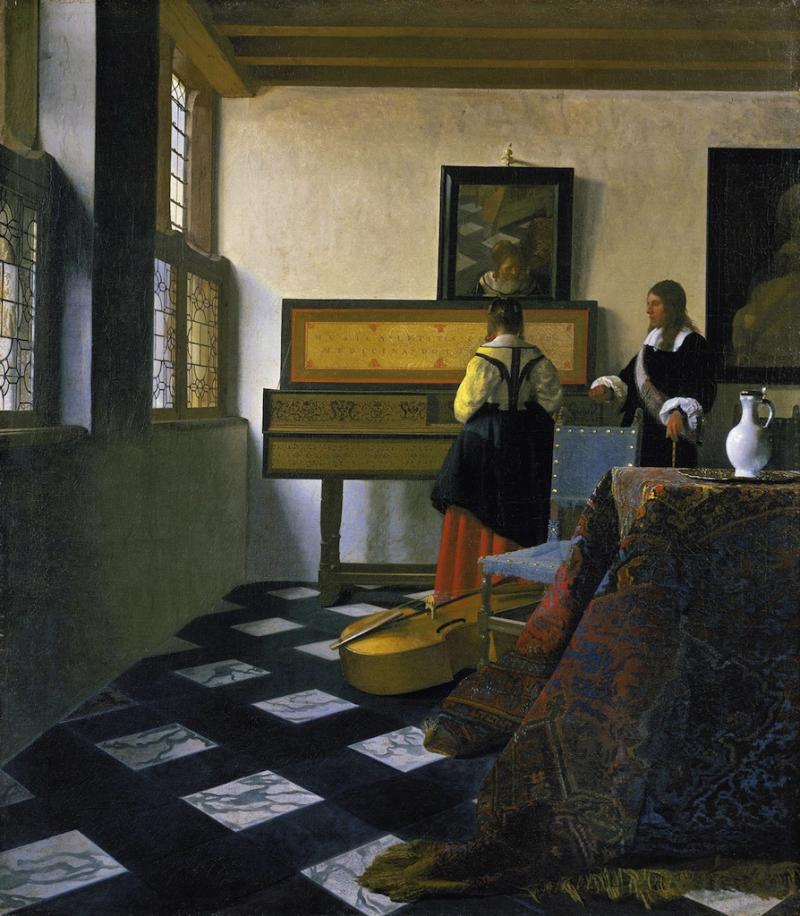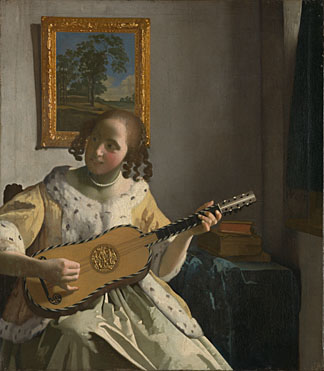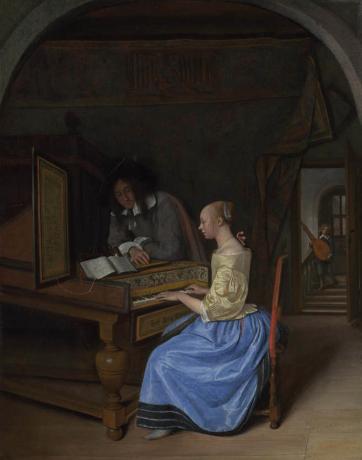Vermeer & Music: The Art of Love and Leisure, National Gallery | reviews, news & interviews
Vermeer & Music: The Art of Love and Leisure, National Gallery
Vermeer & Music: The Art of Love and Leisure, National Gallery
A glorious intertwining of two artforms during the Dutch Golden Age

Music and art have been intertwined for millennia, the static, frozen and soundless moment of paint capturing the feeling and the meaning of ephemeral time-based music. And nowhere can the act of making music have so thoroughly infiltrated a society at all levels than the Golden Age of Dutch culture in the 17th century.
Music is emblematic of time passing and its accompaniment, mortality
Music was part of the entertainment in brothels, bawdy houses, taverns, inns, part of the energetic goings-on of the working classes, and also profoundly integrated into the life and mores of the burgeoning middle-classes of this bubbling, innovative society. Artists supplied countless domestic-sized paintings for the newly wealthy. And it is estimated that a hefty percentage of all painting of the time across this spectrum of subjects also had music as a significant theme.
The meanings were various, and at times melancholy: music is emblematic of time passing and its accompaniment, mortality. But it could also mean celebration, enjoyment, and of course flirtation, courtship and love. This anthology of the period, mostly based on the National’s own collection, is an illuminating illustrated history lesson.
 For the Vermeers, A Young Woman standing at the Virginal and A Young Woman Sitting at the Virginal are from the home collection, The Music Lesson from the Royal Collection, The Guitar Player (pictured right) from Kenwood, and a tiny Young Woman Seated at a Virginal from a private collection in New York. As there are only about 34 (some disputed) surviving Vermeers in total, these five are a good helping: indeed nearly a quarter of his oeuvre has music as its ostensible subject.
For the Vermeers, A Young Woman standing at the Virginal and A Young Woman Sitting at the Virginal are from the home collection, The Music Lesson from the Royal Collection, The Guitar Player (pictured right) from Kenwood, and a tiny Young Woman Seated at a Virginal from a private collection in New York. As there are only about 34 (some disputed) surviving Vermeers in total, these five are a good helping: indeed nearly a quarter of his oeuvre has music as its ostensible subject.
The masterpiece is The Music Lesson (main picture), its ambiguity underlining the exhibition’s theme. The beautifully decorated virginal has its motto inscribed in Latin: “Music is the companion of joy, the medicine of sorrow”. The graceful young woman standing at the virginal, her back to us, has her serene face reflected in the mirror above; by the side of the instrument a formally dressed man in profile may be singing to her accompaniment. On the richly tiled floor a viol da gamba rests, its curved body’s resemblance to a female torso adding to the rich harvest of allusions. An Oriental rug acts as a table cloth, alluding, of course, to the riches brought home by the Dutch East India Company, and on the table top there is a gold salver bearing a demure white jug. The outstanding instrument itself would have been expensive, its quality evident. We are in a grand if domestic interior.
Is the woman a music student, a muse or a lover, or even a wife? Is the man a teacher, a visitor, a relative? Is it a meditation on Orsini’s remark in Twelfth Night, “If music be the food of love, play on”? We don’t know, but we can imagine, we can speculate, while we absorb the intricacy of decoration, of textile and instrument, the glorious orange and yellow of our lady’s dress.
The newly cleaned and resplendent The Guitar Player glitters with gold; the gilded frame of the landscape painting hanging on the wall, a gold lattice on the instrument itself; the pale yellow of the lady’s fur-trimmed overdress, the lemon yellow of her skirt. She cradles the baby-sized guitar almost as though it is a baby.
 Performances in a variety of groupings are explored. In Jan Steen’s A Young Woman Playing a Harpsichord to a Young Man (pictured left, © National Gallery) the harpsichord is inscribed with two mottos: “solely to the glory of God” and “actions prove the man” – the second undermining the piety of the first. In the background, a young man is coming down the stairs into the room carrying a theorbo, perhaps for the potential lover to make a musical duet as a prelude to a further amatory dance.
Performances in a variety of groupings are explored. In Jan Steen’s A Young Woman Playing a Harpsichord to a Young Man (pictured left, © National Gallery) the harpsichord is inscribed with two mottos: “solely to the glory of God” and “actions prove the man” – the second undermining the piety of the first. In the background, a young man is coming down the stairs into the room carrying a theorbo, perhaps for the potential lover to make a musical duet as a prelude to a further amatory dance.
Gabriel Metsu’s A Man and a Woman seated by a Virginal shows a young woman turning away from the keyboard and holding out a piece of music to the young man at her side, who in his turn is gesturing towards her with a flute of wine, in a toast of some kind. Meanwhile, Gerard ter Borch’s A Woman playing a Lute to Two Men shows two behatted men, one perhaps orchestrating the lady player who is reading a piece of music. There are the same props: the rug, the table, the pictures on the wall, the lady’s fur-trimmed house jacket, in its characteristic pale yellow, but here amplified by the pet dog coming into the room, his gaze curious. There is an upturned card on the floor, the ace of spades, and an orange has rolled under the lady’s skirt. A love triangle? Speculation adds to interest.
The paintings are amplified by vitrines containing beautifully crafted period musical instruments: virginal, violin, viol, guitar, lute, cittern, and 17th-century printed songbooks. From Thursday to Saturday throughout the show, the Academy of Ancient Music will play the real thing on the hour every hour.
- Vermeer & Music: The Art of Love and Leisure at the National Gallery until 8 September
Explore topics
Share this article
The future of Arts Journalism
You can stop theartsdesk.com closing!
We urgently need financing to survive. Our fundraising drive has thus far raised £49,000 but we need to reach £100,000 or we will be forced to close. Please contribute here: https://gofund.me/c3f6033d
And if you can forward this information to anyone who might assist, we’d be grateful.

Subscribe to theartsdesk.com
Thank you for continuing to read our work on theartsdesk.com. For unlimited access to every article in its entirety, including our archive of more than 15,000 pieces, we're asking for £5 per month or £40 per year. We feel it's a very good deal, and hope you do too.
To take a subscription now simply click here.
And if you're looking for that extra gift for a friend or family member, why not treat them to a theartsdesk.com gift subscription?
more Visual arts
 'We are bowled over!' Thank you for your messages of love and support
Much-appreciated words of commendation from readers and the cultural community
'We are bowled over!' Thank you for your messages of love and support
Much-appreciated words of commendation from readers and the cultural community
![SEX MONEY RACE RELIGION [2016] by Gilbert and George. Installation shot of Gilbert & George 21ST CENTURY PICTURES Hayward Gallery](https://theartsdesk.com/sites/default/files/styles/thumbnail/public/mastimages/Gilbert%20%26%20George_%2021ST%20CENTURY%20PICTURES.%20SEX%20MONEY%20RACE%20RELIGION%20%5B2016%5D.%20Photo_%20Mark%20Blower.%20Courtesy%20of%20the%20Gilbert%20%26%20George%20and%20the%20Hayward%20Gallery._0.jpg?itok=7tVsLyR-) Gilbert & George, 21st Century Pictures, Hayward Gallery review - brash, bright and not so beautiful
The couple's coloured photomontages shout louder than ever, causing sensory overload
Gilbert & George, 21st Century Pictures, Hayward Gallery review - brash, bright and not so beautiful
The couple's coloured photomontages shout louder than ever, causing sensory overload
 Lee Miller, Tate Britain review - an extraordinary career that remains an enigma
Fashion photographer, artist or war reporter; will the real Lee Miller please step forward?
Lee Miller, Tate Britain review - an extraordinary career that remains an enigma
Fashion photographer, artist or war reporter; will the real Lee Miller please step forward?
 Kerry James Marshall: The Histories, Royal Academy review - a triumphant celebration of blackness
Room after room of glorious paintings
Kerry James Marshall: The Histories, Royal Academy review - a triumphant celebration of blackness
Room after room of glorious paintings
 Folkestone Triennial 2025 - landscape, seascape, art lovers' escape
Locally rooted festival brings home many but not all global concerns
Folkestone Triennial 2025 - landscape, seascape, art lovers' escape
Locally rooted festival brings home many but not all global concerns
 Sir Brian Clarke (1953-2025) - a personal tribute
Remembering an artist with a gift for the transcendent
Sir Brian Clarke (1953-2025) - a personal tribute
Remembering an artist with a gift for the transcendent
 Emily Kam Kngwarray, Tate Modern review - glimpses of another world
Pictures that are an affirmation of belonging
Emily Kam Kngwarray, Tate Modern review - glimpses of another world
Pictures that are an affirmation of belonging
 Kiefer / Van Gogh, Royal Academy review - a pairing of opposites
Small scale intensity meets large scale melodrama
Kiefer / Van Gogh, Royal Academy review - a pairing of opposites
Small scale intensity meets large scale melodrama
 Jenny Saville: The Anatomy of Painting, National Portrait Gallery review - a protégé losing her way
A brilliant painter in search of a worthwhile subject
Jenny Saville: The Anatomy of Painting, National Portrait Gallery review - a protégé losing her way
A brilliant painter in search of a worthwhile subject
 Abstract Erotic, Courtauld Gallery review - sculpture that is sensuous, funny and subversive
Testing the boundaries of good taste, and winning
Abstract Erotic, Courtauld Gallery review - sculpture that is sensuous, funny and subversive
Testing the boundaries of good taste, and winning
 Edward Burra, Tate Britain review - watercolour made mainstream
Social satire with a nasty bite
Edward Burra, Tate Britain review - watercolour made mainstream
Social satire with a nasty bite
 Ithell Colquhoun, Tate Britain review - revelations of a weird and wonderful world
Emanations from the unconscious
Ithell Colquhoun, Tate Britain review - revelations of a weird and wonderful world
Emanations from the unconscious

Add comment